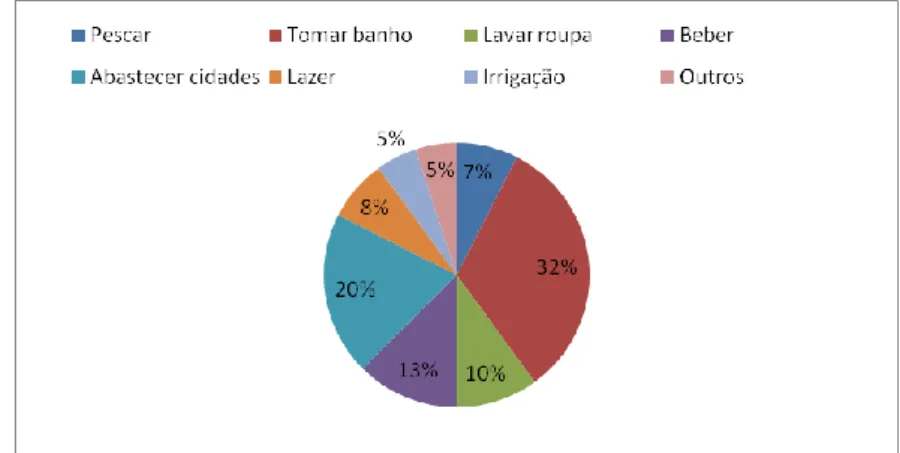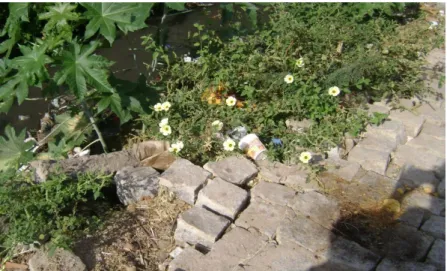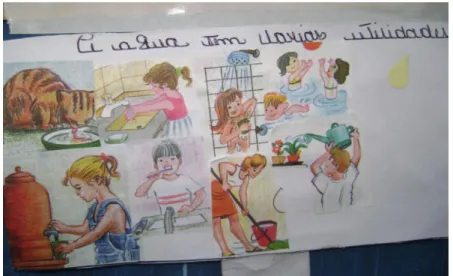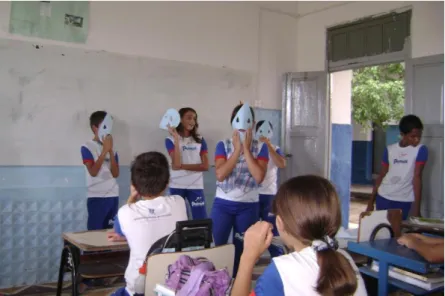Artigo Científico
REBAGA (Pombal – PB – Brasil) v.5, n.1, p. 14 - 22 janeiro/dezembro de 2011
http://www.gvaa.com.br/revista/index.php/RBGA/index
Development of students 'perception of the 7
thyear of basic education in a public
school about the consious use of the water
Luci Cleide Farias Soares Sousa
Prof. Licenciada em Letras (Português e Inglês) Especialista em Língua Inglesa – Rua Odilon José de Assis nº 256, Pombal - PB. E-mail: cleidesoares@msn.com.br
Jessenildo Elson da Silva Sousa
Graduando em Ciências, UFCG – Rua Leonidas Henrique Formiga nº 357, Pombal PB
José da Silva Sousa
Mestrando em Agronomia, PPGA/CCA/UFPB - Rua Odilon Jose de Assis nº 256, Pombal - PB. E-mail: silva_agronomo@hotmail.com
Emmanuel Moreira Pereira
Universidade Federal De Campina Grande – Unidade Acadêmica de Agronomia e-mail: emmanuel16mop@hotmail.com
Maria da Glória Borba Borges
Licenciada em Estudos Sociais e M. Sc. em Gestão Ambiental e professora da Secretaria da Educação do Estado da Paraiba E-mail: borbagloria@hotmail.com
Vivian Patrícia Borba Borges Maracajá
Bacharel em Turismo pela FACISA – Campina Grande - PB E-mail: borbav@hotmail.com
Almair de Albuquerque Fernandes
Mestrando do Programa de Pós-Graduação em Sistemas – Agroindustriais - PPGSA da UFCG/CCTA/ POMBAL – PB E-mail: almairalburquerque@hotmail.com
Aline Carla de Medeiros
Especialista em Educação Ambiental – FIP – Patos/PB. E-mail: alinecarla.edu@gmail.com
ABSTRACT - Water is a vital natural resource for the existence of living beings, it would be impossible without it
there is life on the planet, however, a finite resource, which has an economic value, worthy of rational and conscious use. The objective of this work was the development of students' perception of the 7th year of primary education in a public school about the conscious of the use of water. The same was developed in a public school in the municipality of Pombal - PB, with a group of 40 students enrolled in the 7th grade of elementary school. It was applied 40 questionnaires containing 12 questions in order to make a survey about students 'prior knowledge on the subject, but also develop the students' perception about the conscious use of water. By applying a didactic sequence, with the application of a questionnaire, a lecture, a visit to canal station and water treatment, and finally, presentation of a play. There were several answers when asked about the usefulness of water for drinking, bathing, cooking and irrigation, were the most cited. With respect to the origin of the water they use the students answered wells, ponds, rivers, tanks and CAGEPA. However, there is a need for educational campaigns that can facilitate the learning of them on the subject.
Keywords: water, conscious use, environmental education
Desenvolvimento da perceção dos alunos do 7º ano do ensino fundamental em
uma escola pública sobre o uso consciente da água
RESUMO – A água é um recurso natural vital para a existência dos seres vivos, sem ela seria impossível existir vida no
planeta, porém, um recurso finito, que possui um valor econômico, digno de uso racional e consciente. Objetivou-se com este trabalho o desenvolvimento da perceção dos alunos do 7º ano do ensino fundamental em uma escola pública sobre o uso consciente da água. O mesmo foi desenvolvido em uma escola da rede pública no município de Pombal - PB, com um grupo de 40 alunos, matriculados no 7º ano do ensino fundamental. Foram aplicados 40 questionários contendo 12 questões com o intuito de fazer um levantamento sobre os conhecimentos prévios dos alunos sobre o assunto, como também desenvolver a percepção dos alunos sobre o uso consciente da água. Através da aplicação de uma seqüência didática, com a aplicação de um questionário, uma palestra, visita a um canal e a estação de tratamento
Artigo Científico
REBAGA (Pombal – PB – Brasil) v.5, n.1, p. 14 - 22 janeiro/dezembro de 2011
http://www.gvaa.com.br/revista/index.php/RBGA/index
de água, e por último, apresentação de uma peça teatral. Varias foram às respostas quando questionados sobre a utilidade da água, serve para beber, tomar banho, cozinhar e irrigação, foram as mais citadas. Com relação à origem da água utilizada pelos mesmos, os alunos responderam poços, açudes, rios, cisternas e CAGEPA. No entanto, existe a necessidade de campanhas educativas que possam facilitar o aprendizado dos mesmos sobre o assunto.
Palavras chave: água, uso consciente, educação ambiental
INTRODUCTION
Water availability is critical to the functioning of natural systems and cycles for sustaining human life in the planet.
According to Barros (2010) the waters that occur in nature make up the hydrosphere, which has a volume of 1.46 billion cubic kilometers, a high availability of water around the globe encouraged a policy of waste of water resources in many parts of the world. According to Law 9433/97 of water is necessary to understand that water is a finite resource, endowed with an economic value, it should be used rationally to ensure current and future generations.
In percentage terms, announces that 100% of water on Earth is 97% and 3% salt water and fresh water. 3% fresh water, are frozen 2.3, 0.2% are involved in constant processes of evaporation and transpiration and only 0.5% are available to mankind. (ARAUJO and SANTAELLA, 2003)
According to surveys, water remains the same in quantity, Campos and Stuart (2003), but not in quality due to pollutants released into rivers, springs, lack of sanitation in rural areas, domestic sewage released "in natura" in rivers.
For Campos and Stuart (2003) the perception of scarcity of water for human consumption, either by increased water demand due to population growth and economic development, is the increasing deterioration of the quality of this natural resource, can lead to a new world war.
Water shortages for many countries can be a limiting factor for development. Some countries such as Israel, Palestinian Territories, Jordan, Libya, Malta and Tunisia to water scarcity have reached very dangerous levels: there are only 500 m3/habitante-1.ano-1, while it is estimated that the minimum requirement for a person to be m3/habitante-1.ano-1 2000.
According to Lorentz and Mendes (2008) is currently a lack of water severely affects 26 countries, besides those already mentioned are in this situation: Saudi Arabia, Iraq, Kuwait, Egypt, Algeria, Burundi, Cape Verde, Ethiopia, Singapore, Thailand, Barbados, Hungary , Belgium, Mexico, United States, France, Spain.
Brazil is a privileged country in water resources, since it has 14% of the world's freshwater surface of the world, followed by China (9%), United States (8%) and Canada (8%). However, the Brazilian situation also needs care. Although the country has a large hydro potential, the
reservation is not distributed evenly in our territory (FIETZ, 2006).
The Northeast region experiences frequent droughts, there are serious problems of supply in other regions that are already identified and known. Alerts of international organizations mention that in the next 25 years, about 3 billion people will live in regions with extreme water shortages, including for their own consumption. The idea that most people have with regard to water is that it is infinitely abundant and its renewal is natural.
All these situations have led governments worldwide to reorganize the institutional environment and to define new rights and obligations of ownership through a system of management of water resources in a participatory, decentralized and encourage the use of water in a rational way (TUNDISI, 2003).
High levels of loss in the use of water resources, for example, are unacceptable and represent, in many countries, massive financial waste that could be invested in solving problems of water supply and treatment for millions of people. If the management has the active participation of community fully worked out, the losses can be substantially reduced.
The development of work in public school, using a didactic sequence, aimed at developing the capacity of perception and environmental awareness, leading students to reflect on the rational use of water.
MATERIALS AND METHODS
The study was conducted in two classrooms in a public school education in the town of Pombal - Paraíba, with 40 students currently enrolled in 7th grade of elementary school. It was used a didactic sequence with five different activities: The application of a questionnaire, a lecture, a visit to canal station and water treatment, and finally, presentation of a play. Initially a questionnaire was administered at a dose (12) questions aiming to raise the students' prior knowledge on the subject; next step was to conduct a lecture given by a student of the period of the 9th Course UFCG Environmental Engineering - Federal University of Campina Grande with the theme "water". Sequentially, the students visited a city canal that empties into the river Piancó, about 1,000 meters from the school where they study, then visited the CAGEPA - Company of Water Supply and Sewerage of Paraiba, which accompanied the process of water treatment. Finally, students were divided
Artigo Científico
REBAGA (Pombal – PB – Brasil) v.5, n.1, p. 14 - 22 janeiro/dezembro de 2011
http://www.gvaa.com.br/revista/index.php/RBGA/index
into 5 groups of 8, to organize plays, with the help of art teacher, to present, with the following themes: Rational use of water and its effects on the environment, irrational use of water and its effects on the environment, distribution of water on the planet, the importance of the hydrological cycle and water pollution. The only issues were suggested for each target group. The students were charged with organizing the presentations using the knowledge gained on each topic during the development of the proposed work.
RESULTS AND DISCUSSION
The sequence focuses on teaching the topic of water used, it can be understood as a set of linked activities, designed to teach content, step by step. Organized according to the objectives the teacher wants to achieve for the learning of their students, they involve learning activities and assessment (DOLZ, NOVERRAZ and SCNEUWLY, 2004).
This sequence of sharp educational was organized and implemented aiming at developing the students' perception about the conscious and rational use of water. According to Campos (2003) the word perception, derived from the Latin percipere means to apprehend by the senses, learn by the sense that each thing can do in our lives.
The didactic sequence was applied as follows: the first activity of the work was the application of a questionnaire with 12 questions, it was possible determine the knowledge that they possessed on the subject.
Through the analysis of the questionnaires can be observed within the group studied and some information pertaining to the subject as well as some totally misrepresented the issues raised.
When asked what it is for water, accounted for drinking, bathing, cooking, washing clothes, for use in plantations, home to brush their teeth. It was cited by students, the use of water for watering livestock, irrigation, though much of the group resides in rural areas,
were not mentioned too, fauna and flora, power generation, navigation, dilution of pollutants, observed in some responses to lack of knowledge about water and its uses, students have no knowledge about the extent of uses of water resources. There is a need for educational campaigns that can facilitate the learning of them on the subject.
Understand that applying a policy to promote the importance of environmental education mainly focused on sustainability already in primary schools, create new generations in the proper mindset and conservation will be much easier to implement policies aimed at sustainable use of planetary resources in the future. (ABREU, 2008).
Another issue discussed was related to the origin of the water that you use the most relevant answers and accounted coming from rivers, ponds, wells, cisterns and CAGEPA (Water and Sewage Company of Paraíba).
According to respondents the water used by them goes to the sewer, septic tank, river, soil, road, plants, demonstrating in large part to lack of knowledge, or even the lack of structure in which these communities live, where often the sewers run in the open. Amancio (2008) stated that according sources with the Ministry of Cities, 2004, less than 50% of the population have satisfactory sanitation, and most locations this service is met with in large cities. According to Holland (2006) is a worrying statistic that 80% of Brazilian domestic sewage going into rivers without treatment. This situation of the sanitation sector has very serious consequences for the quality of life, especially those poorest, living on the outskirts of large cities or in small and medium towns.
When asked about the usefulness of the river, they answered that serves for bathing, fishing, washing, drinking, planting, and supply the city for leisure, demonstrating to know about some of the same utilities, not citing other uses such as navigation generation of electricity. Students know the river as a means to transport people and food, but do not know the contribution of the river in the process of power generation. To Freitas (2011) the production of electricity by hydroelectric plants is another important contribution of the rivers.
Artigo Científico
REBAGA (Pombal – PB – Brasil) v.5, n.1, p. 14 - 22 janeiro/dezembro de 2011
http://www.gvaa.com.br/revista/index.php/RBGA/index
Virtually all the population surveyed is aware of a river or have visited any, rivers mentioned by respondents were: Rio Piranhas, Pianco, Rio do Peixe, San Francisco, and Tietê if they were dirty when visited, they
answered whys were smeared with mud, garbage, sewage sludge, which confirms the idea forwarded by Araújo and Santaella (2003) hardly any pollution occurs in a single environment and a unique way.
FIGURE 2. Rivers that respondent know or have visited
Some students said they were clean because they had clear water. The "clear water" were the standard for them to affirm that the river was clean, thus demonstrating not aware of several other features that according to Araújo and Santaella (2003) can be physical, chemical or biological weapons as turbidity, pH, alkalinity, hardness, chemical oxygen demand, biochemical oxygen demand, dissolved oxygen, nitrates, heavy metals, coliforms, fertilizers, pesticides, light penetration, etc..
All respondents have entered into a river and most of them already took a bath in them, which may be related to the presence of a river that runs through our town of Pombal.
As the third proposed activity, the students attended a lecture given by a student of 9 th period of the Course of Environmental Engineering UFCG - Federal
University of Campina Grande with the theme "water", the objectives of this activity have been achieved since the students participated and took questions.
Activity in the fourth the students visited a city canal that empties into the river Piancó, about 1,000 meters from the school where they study, and CAGEPA - Company of Water Supply and Sewerage of Paraiba, which accompanied the process of water treatment.
Visit the channel aimed to show the reality of the river, where we observed the amount of industrial and domestic waste are thrown into the river daily (Figure 3), moreover, students still found the amount of litter accumulated near the channel (Figure 4) by nearby residents, although there is a regular service of garbage collection in the city.
Artigo Científico
REBAGA (Pombal – PB – Brasil) v.5, n.1, p. 14 - 22 janeiro/dezembro de 2011
http://www.gvaa.com.br/revista/index.php/RBGA/index
According to Araújo and Santaella (2003) the primitive idea of the waste and domestic and industrial wastewater can be disposed in water bodies, because they have the capacity to dilute and degrade the waste and pollutants dumped in them, began to be fought with more intensity from the 70.
Note, the lack of public awareness, which requires an environmental education. It is understood by
the process of environmental education learning and communication problems related to the interaction of men with their natural environment. It is the instrument for forming an awareness through knowledge and reflection on the environmental. (COSTA, 2004), a participatory process through which individual and collective social values construct ... (MOTA and AQUINO, 2003).
FIGURE 4. Garbage dumped the banks of the canal, as plastic bottles, bags, plastic cups.
For the visit to CAGEPA, students attended, taking the explanations, a company official about the whole process of treating water for city supply, Figure 4. Some questions were raised by students and doubts were
taken during the explanations. It was noted that they followed the course indicated by listening to the explanations carefully. Figure 5.
FIGURE 5. Visit CAGEPA. The students were accompanied by an officer who explained all the stages of water
treatment undertaken by the company.
Artigo Científico
REBAGA (Pombal – PB – Brasil) v.5, n.1, p. 14 - 22 janeiro/dezembro de 2011
http://www.gvaa.com.br/revista/index.php/RBGA/index
FIGURE 6. Students following the technical and observing the phases of water treatment.
Finally, the fifth work activity, students were divided into 5 groups of 8, to organize plays, with the help of art teacher, to present, with the following themes: Rational use of water and its effects on the environment, irrational use of water and its impact on the environment, distribution of water on the planet, the importance of the hydrological cycle and water pollution. The students were
asked to prepare material for presentation by what they had seen in class.
On the topic "Rational use of water", the students organized a poster presentation, Figure 6, and lines between the characters that took place in a classroom, a teacher (student) explaining to the students present on the importance of water and about the need for rational consumption. Figure 7.
Artigo Científico
REBAGA (Pombal – PB – Brasil) v.5, n.1, p. 14 - 22 janeiro/dezembro de 2011
http://www.gvaa.com.br/revista/index.php/RBGA/index
FIGURE 8. The teacher (student) group: "Rational use of water," leads the class on the proposed theme in the play
The other groups have also produced posters and divided between the lines and characters relevant to the topics suggested.
The group that presented the play on "The importance of the hydrological cycle", each student took a
role as an element of the cycle, showing the operation thereof, as well as its importance. The group produced light blue cardboard masks in droplet model to use during
the presentation. Figure 9
FIGURE 9. Presentation of the group "The importance of the hydrological cycle."
According to the presentation of plays, it was found that there was a significant learning in class, showing that the leading these assimilated during the presentations were stressed the importance of preserving nature, and to use our water, learned to identify if the environment is free from any kind of pollution, elementary knowledge of the fauna and flora, so you can better see the river as an ecosystem and not just more like a water resource. Students come to know and understand about what processes cannot occur near a river, to prevent it from being polluted.
The theater as an instrument of information and participation, aims to encourage students to interact with the school community as well as the diffusion of environmental theme. Camargo (2003) explains that the theater, the school provides experiences that contribute to the integrated growth of children and adolescents in many ways.
At the individual level, provides insight into the development of the world, expressive and artistic capabilities, at the collective level, as a group activity, offers the performance of cooperative relations, dialogue, mutual respect, reflection on how to work with colleagues,
Artigo Científico
REBAGA (Pombal – PB – Brasil) v.5, n.1, p. 14 - 22 janeiro/dezembro de 2011
http://www.gvaa.com.br/revista/index.php/RBGA/index
flexibility, acceptance of differences and the acquisition of its autonomy as a result of being able to think and act with greater freedom.
There is a consensus for several authors that the school must prepare citizens, sensitizing them to their citizenship, but the second Freire (1987), there is an awareness before and after a world and not vice versa, because the intentionality of human consciousness do not die in a thick mantle without reverse. School always has dimension greater than the horizons that surround it.
CONCLUSION
It was noted, the lack of public awareness, requiring a more consistent environmental education;
The majority of respondents do not have much notion of the origin of water they use as well, the same fate after use;
According to the data collected there is a need for a policy that promotes the importance of environmental education mainly focused on sustainability already in primary schools;
REFERENCES
A falta de saneamento básico no Brasil Edição 419 do
Jornal Inverta, em 01/01/2008 http://inverta.org/jornal/edicao-impressa/419/economia/a-falta-de-saneamento-basico-no-brasil.
A Importância da Educação Ambiental: Sustentabilidade Autor: Carlos Abreu • 25 de setembro de 2008 http://www.atitudessustentaveis.com.br/conscientizacao/a-importancia-da-educacao-ambiental-sustentabilidade/ ARAÚJO, J. C; SANTAELLA, S. T. Gestão da qualidade. Gestão de Águas: princípios e práticas. 2. Ed./ Editado por Nilson Campos e Ticiana Stuart. Porto Alegre: ABRH, 2003. 242p.
BARROS, J. G. C. Origem, Distribuição e Preservação da Água no Planeta Terra
http://revistadasaguas.pgr.mpf.gov.br/edicoes-da-revista/edicao-11/materias/origem distribuicao-e- preservacao-da-agua-no-planeta-terra PGR | 4ª CCR | Ano 4 | Número 10 | Dezembro 2010
CAMARGO, M. A. Teatro na escola: a linguagem da inclusão. Passo Fundo: UPF, 2003.
CAMPOS, N; STUDART, T. Gestão de Águas:
princípios e práticas. 2. Ed./ Editado por Nilson Campos
e Ticiana Studart. Porto Alegre: ABRH, 2003. 242p. COSTA, M. V. O currículo nos limiares do
contemporâneo. Rio de Janeiro: DP e A, 1988.
DOLZ, NOVERRAZ e SCNEUWLY. Seqüências didáticas para o oral e a escrita: apresentação de um procedimento. In. DOLZ & SHNEUWULY (orgs) Gêneros Orais e Escritos na Escola. São Paulo: Mercado de Letras, 2004.
FIETZ, C. R. Água, o recurso natural do terceiro
milênio. A Lavoura. Junho, p 18 e 19, 2006.
FREIRE, P. Pedagogia do Oprimido. Paz e Terra, Rio de Janeiro. 1987.
FREITAS, Eduardo. A importância dos rios para geração de energia. http://mundoeducacao.uol.com.br/geografia/a-importancia-dos-rios-para-geracao-energia.htm
HOLANDA, A. Revista Bons Fluídos. 04/2006 Poluição:
Águas claras
http://planetasustentavel.abril.com.br/noticia/ambiente/con teudo_226003.shtml
MOTA, S; AQUINO, M. D. Gestão Ambiental. Gestão de Águas: princípios e práticas. 2. Ed./ Editado por Nilson Campos e Ticiana Studart. Porto Alegre: ABRH, 2003. 242p.
TUNDISI, J. G. Água no século XXI: Enfrentando a
Escassez. São Carlos. RiMA, IIE. 2003. 248p




